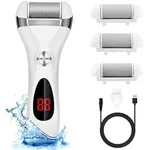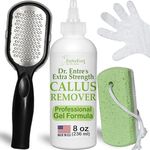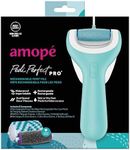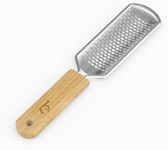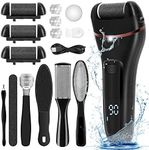Buying Guide for the Best Callus Removers
Choosing the right callus remover can make a big difference in your foot care routine. The goal is to find a product that safely and effectively removes tough, thickened skin without causing irritation or injury. When shopping for a callus remover, it's important to consider how you plan to use it, your skin sensitivity, and how much effort you want to put into the process. Understanding the key features will help you select a tool that matches your needs and keeps your feet smooth and healthy.Type (Manual vs. Electric)Callus removers come in two main types: manual and electric. Manual removers include files, pumice stones, and rasps, which require you to physically rub the tool against your skin. Electric removers use a motorized roller or blade to do the work for you. Manual tools are simple, quiet, and give you more control, making them a good choice for those with sensitive skin or who prefer a gentle approach. Electric models are faster and require less effort, which is ideal if you have thicker calluses or limited hand strength. Think about your comfort level and how much time you want to spend on foot care when choosing between these types.
Abrasiveness/CoarsenessAbrasiveness refers to how rough the surface of the remover is. Coarse surfaces remove thick, tough calluses quickly, while finer surfaces are gentler and better for smoothing or maintaining soft skin. Some tools offer interchangeable heads or dual-sided surfaces for different levels of coarseness. If you have very thick or stubborn calluses, a coarser tool may be necessary, but for regular maintenance or sensitive skin, a finer option is safer and more comfortable. Consider the condition of your feet and whether you need heavy-duty removal or just light smoothing.
Safety FeaturesSafety features help prevent injury while using the callus remover. These can include protective covers, ergonomic handles for a secure grip, or built-in sensors that stop the device if too much pressure is applied. For electric models, look for automatic shut-off or speed control. If you are new to callus removal or have sensitive skin, prioritizing safety features can help you avoid cuts, scrapes, or over-exfoliation. Choose a tool that feels comfortable and safe in your hand, especially if you plan to use it frequently.
Ease of CleaningKeeping your callus remover clean is important for hygiene and the longevity of the tool. Some removers are waterproof and can be rinsed under running water, while others have removable heads that can be washed separately. Manual tools are often easier to clean, but some electric models are designed for easy maintenance as well. If you want a hassle-free experience, look for a remover that is simple to take apart and clean after each use.
Power Source (for Electric Models)Electric callus removers can be powered by batteries, rechargeable batteries, or a direct plug-in. Battery-powered models are portable and convenient for travel, but you’ll need to replace batteries regularly. Rechargeable models are more eco-friendly and cost-effective in the long run, but require charging between uses. Plug-in models offer consistent power but limit mobility. Think about where and how often you’ll use the remover to decide which power source fits your lifestyle best.



